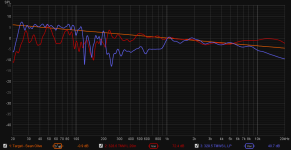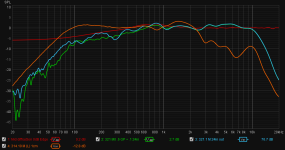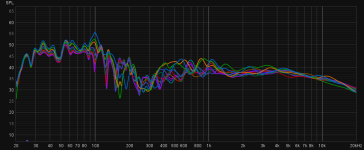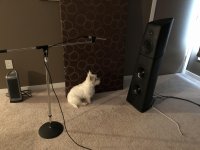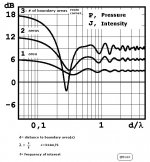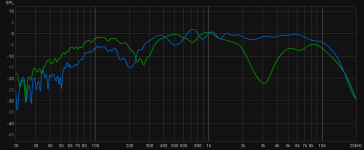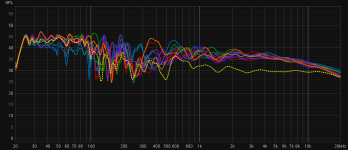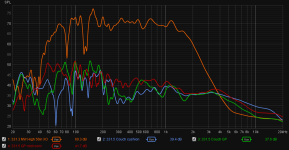I recently finished building a new set of active 3 ways and am happy with v1.0 of the crossover, but need some advice on the room response.
The red trace is one 3way speaker from 20" run full range. The light blue trace is from the listening position and is crossed over to a sub at 80Hz. My question is what to make of the depression between 200Hz and 1kHz at the LP. I took measurements along the couch and the width of the depression narrows as you you move along the couch, but never goes away 100%. Filling it in with EQ sounds subtly wrong.
Does everyone EQ the modal region and then forget ignore everything above it?
The red trace is one 3way speaker from 20" run full range. The light blue trace is from the listening position and is crossed over to a sub at 80Hz. My question is what to make of the depression between 200Hz and 1kHz at the LP. I took measurements along the couch and the width of the depression narrows as you you move along the couch, but never goes away 100%. Filling it in with EQ sounds subtly wrong.
Does everyone EQ the modal region and then forget ignore everything above it?
Attachments
I recently finished building a new set of active 3 ways and am happy with v1.0 of the crossover, but need some advice on the room response.
What are the crossover points on your speakers?
If you look closely you will see a dip in both graphs at about 160hz also at the 1k region on both there is an exaggerated rise in output leading into the highs. On a 3 way system that could represent a phasing issue in the crossover regions between your woofer-mid and mid-tweeter. Whether that is true here or not would depend on your crossover frequencies.
I recently finished building a new set of active 3 ways and am happy with v1.0 of the crossover, but need some advice on the room response.
It's hard to diagnose without a proper measure. You really need to perform a gated FR measure, in a moderate sized room you should be able to attain 200Hz precision or even better, and then you'll easily see if the FR is really flat or not. I suspect you didn't account for baffle step loss.
Ralf
This is useful information. Irregularities at the listening position can be an indicator of a problem. Sometimes you can EQ to it and sometimes you cannot. It depends on the issue.Filling it in with EQ sounds subtly wrong.
Does everyone EQ the modal region and then forget ignore everything above it?
I agree with the others that there needs to be more information. In addition to what's been said I'd ask for a photo and/or a description of the speaker.
It seems very odd that there'd be such a broad-band effect. Normally, acoustic issues will tend to show up at a particular frequency, maybe with a few harmonics: floor bounce etc.
A near-perfect 6dB loss across two octaves is quite impressive, really.
An alternative theory would be that you're using dipole mid/bass and monopole HF with a ~1kHz crossover. The room excitation would vary according to frequency. With some broad-band absorption behind speakers of that description, I can imagine getting similar response curves.
Knowing what the speakers are would help. Taking the sub out and running the speakers full-range would also be informative.
Chris
A near-perfect 6dB loss across two octaves is quite impressive, really.
An alternative theory would be that you're using dipole mid/bass and monopole HF with a ~1kHz crossover. The room excitation would vary according to frequency. With some broad-band absorption behind speakers of that description, I can imagine getting similar response curves.
Knowing what the speakers are would help. Taking the sub out and running the speakers full-range would also be informative.
Chris
I started off doing gated measurements with Holm, but was getting nearly identical results with REW and was tired of the two apps fighting over ASIO control, so I abandoned Holm once I felt comfortable with the correlation between the two apps. The only obvious benefit with Holm was that it provided smoother FR near 1kHz.
The first pic is series of outdoor measurements comparing of BSD for
My theory for the discrepancy between Edge and reality is the baffle is slightly curved and has huge roundovers, so the shape is correct, but reality is shifted up in frequency. That and the fact that other investigations I have seen of BSD don't agree with Edge.
The crossover points are 1.6kHz, 250Hz, 80Hz, all LR4.
I am happy enough with my midrange measurements and I get a decent reverse null at 1.6kHz, but my GP woofer measurements don't show much baffle step (maybe that's just closer proximity to ground?) and I don't measure a good reverse null at 250Hz (at least indoors).
The time delays for T-M-W were set using measurements taken at 6ft, and the delay to Subs determined with a measuring tape and confirmed to provide smoothest FR with various delays at the LP.
I can take the speakers back outside eventually, but it's a big affair and the weather has to be cooperative. I ran out of daylight last time.
Maybe the midrange suckout in the room response is just a result of reflections. The 2nd photo is various positions along our long couch, taken before EQing out room modes below 100Hz.
The first pic is series of outdoor measurements comparing of BSD for
- The midrange from Edge in red
- The actual 2ft measurement in blue
- 2ft spliced to ground plane in green
- 1cm comparison
My theory for the discrepancy between Edge and reality is the baffle is slightly curved and has huge roundovers, so the shape is correct, but reality is shifted up in frequency. That and the fact that other investigations I have seen of BSD don't agree with Edge.
The crossover points are 1.6kHz, 250Hz, 80Hz, all LR4.
I am happy enough with my midrange measurements and I get a decent reverse null at 1.6kHz, but my GP woofer measurements don't show much baffle step (maybe that's just closer proximity to ground?) and I don't measure a good reverse null at 250Hz (at least indoors).
The time delays for T-M-W were set using measurements taken at 6ft, and the delay to Subs determined with a measuring tape and confirmed to provide smoothest FR with various delays at the LP.
I can take the speakers back outside eventually, but it's a big affair and the weather has to be cooperative. I ran out of daylight last time.
Maybe the midrange suckout in the room response is just a result of reflections. The 2nd photo is various positions along our long couch, taken before EQing out room modes below 100Hz.
Attachments
Plug your numbers in here... what do you get?:
Floor/Ceiling Reflection Calculator
Floor/Ceiling Reflection Calculator
That calculator says the floor bounces are within the broad dip.
In the next day or two I will try making some more measurements. See if I can predict/confirm floor bounce frequency at different listening positions, move coffee table, see if that broad dip can be replaced with a single null, etc.
In the next day or two I will try making some more measurements. See if I can predict/confirm floor bounce frequency at different listening positions, move coffee table, see if that broad dip can be replaced with a single null, etc.
Looking at pic 2 in post #9 looks a lot like boundary gain and suck out.
Suck out occurs roughly at 0.3 x the wavelength from the boundary. Such as 340mm from the boundary it will happen at 300Hz, 410mm it will happen at 250Hz etc. The aim is to have distance to all boundaries (walls, floor) from the woofer to be different as much as possible and no direct multiples. If you have 2 or 3 of these distances the same, the issue increases dramatically (see pic). Roy F. Allision did a lot of work on this and there was a discussion in this thread.
Designing principles for near the wall-speakers
Gain happens at roughly <0.2 x the wavelength.
You could always measure the speaker placed greater than 1.3m from any boundary to see if boundaries, speaker placement, are an issue.
Suck out occurs roughly at 0.3 x the wavelength from the boundary. Such as 340mm from the boundary it will happen at 300Hz, 410mm it will happen at 250Hz etc. The aim is to have distance to all boundaries (walls, floor) from the woofer to be different as much as possible and no direct multiples. If you have 2 or 3 of these distances the same, the issue increases dramatically (see pic). Roy F. Allision did a lot of work on this and there was a discussion in this thread.
Designing principles for near the wall-speakers
Gain happens at roughly <0.2 x the wavelength.
You could always measure the speaker placed greater than 1.3m from any boundary to see if boundaries, speaker placement, are an issue.
Attachments
Last edited:
Mid (blue) and woofers (green) measured at 6ft outdoors. In hindsight, it would have been a good idea to move the woofers down to the bottom of the lower cabinet (instead of centered vertically) in order to shift their floor bounce higher in frequency. Then I could have crossed from the mids to the woofers at the midpoint of their respective floor bounce frequencies.
I will soon measure both from the LP to see where their nulls are.
I will soon measure both from the LP to see where their nulls are.
Attachments
The first image includes measurements taken near the center of the couch, at different heights and distances from the back wall, but none at the far left or right. With their impulses aligned perfectly in the overlay window, the vector average ended up sloping too much at high frequencies. Anyone know why?
The second image's orange trace is a sanity check of the mid and woofers (with crossovers still on) 56" away and higher than the design axis--ballpark 50". It looks flat overall as I would hope.
The blue and green traces are with the mic on a cushion and on the floor in front of the couch. They reflect the fact that every measurement on that end of the room will have some depression between 250 and 500Hz. I think it's a function of the geometry of the room and the listening distance, and likely nothing I can do about it (moving the coffee table did nothing).
The red trace is a ground plane from the centerish of the room--no depression.
The second image's orange trace is a sanity check of the mid and woofers (with crossovers still on) 56" away and higher than the design axis--ballpark 50". It looks flat overall as I would hope.
The blue and green traces are with the mic on a cushion and on the floor in front of the couch. They reflect the fact that every measurement on that end of the room will have some depression between 250 and 500Hz. I think it's a function of the geometry of the room and the listening distance, and likely nothing I can do about it (moving the coffee table did nothing).
The red trace is a ground plane from the centerish of the room--no depression.
Attachments
- Status
- This old topic is closed. If you want to reopen this topic, contact a moderator using the "Report Post" button.
- Home
- Loudspeakers
- Multi-Way
- Midrange depression in room response
